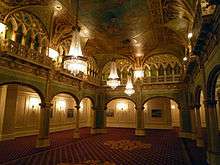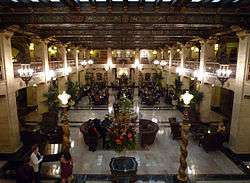The Davenport Hotel (Spokane, Washington)
|
The Davenport Hotel | |
.jpg) | |
| Location |
10 South Post Street Spokane, Washington |
|---|---|
| Coordinates | 47°39′24.5″N 117°25′27.65″W / 47.656806°N 117.4243472°WCoordinates: 47°39′24.5″N 117°25′27.65″W / 47.656806°N 117.4243472°W |
| Built | 1914 |
| Architect | Kirtland Kelsey Cutter |
| Architectural style | Mission/Spanish Revival |
| NRHP Reference # | 75001874 [1] |
| Added to NRHP | September 5, 1975 |
The Davenport Hotel [2][3] is a hotel located in Spokane, Washington. Commissioned by a group of Spokane businessmen, the hotel is named after Louis Davenport, its first proprietor and overseer of the project. Architect Kirtland Cutter designed the building in 1914. The Davenport Hotel was the first hotel in the United States with air conditioning, a central vacuum system, pipe organ, and dividing doors in the ballrooms. It is also the place at which the first Crab Louis (named after Louis Davenport) was created and served. The hotel is listed on the National Register of Historic Places.
The Davenport Hotel was completely restored by developer Walt Worthy in 2002 and operates today under the name The Historic Davenport Hotel within The Davenport Hotel Collection brand along with its three sister hotels.
History
Early years
Lewellyn "Louis" Davenport came to Spokane Falls, Washington Territory, in the spring of 1889 at the age of 20. He had been a clerk in San Francisco and came up to Spokane to work the summer in his uncle's "Pride of Spokane Restaurant." The summer of 1889 was fateful for Spokane and for Louis Davenport. In August, a fire tore through the infant metropolis, turning 32 square blocks of civilization to ashes. Young Davenport salvaged what he could from the rubble, bought a tent, and opened "Davenport's Waffle Foundry." Spokane rebuilt quickly after the big fire. Washington became a state that winter and Spokane dropped the Falls from its name. With timber, mining, agriculture and the railroad pouring money and people into the region, the city of Spokane was in the middle of it all and poised to become one of the great cities of the West.
Davenport recognized his opportunity and leased a brick building on the North-east corner of Sprague Avenue and Post Street the next year. He expanded his culinary offerings to nearly 100 items. Within a few years, Davenport's Restaurant was described by a critic as "the finest thing of the kind in the country." Business was so good, Davenport expanded into an adjoining building within a decade. He hired up-and-coming architect, Kirtland Cutter, to make the two buildings appear as one in 1904. Cutter offered a Mission Revival style theme. The white stucco walls and red tile roofs stood in marked contrast to every other building downtown.[4] This remodel added the finest ballroom in the West on the second floor, the Hall of the Doges.
Construction of the hotel tower
The Davenport Hotel was neither Louis Davenport's idea nor was it built with his money, as it was leading businessmen who desired a large public house in which to board and entertain their guests. Their searches for the best men of architecture and hospitality ended with their first choices, Cutter and Davenport. Leveraging Davenport's already strong name, the Davenport Hotel Company was formed in 1912 and preparation of the site began that year. The hotel tower went up in eight months of 1913 using horse carts, steam jacks and hand tools. Not a single worker was seriously injured or killed—a rarity for the time. Cutter and Davenport shopped the world for ideas and furnishings for their new hotel.[4] Cutter designed spaces inspired by the great architects of France, England and Spain. Davenport filled them with fine art and songbirds and prepared to seat his guests at tables dressed in the finest Irish linens from Liddell (whose linens sailed on the Titanic) and set with 15,000 pieces of silver (the largest private commission ever created by Reed and Barton). Ever since opening day, the hotel has promoted itself as "one of America's exceptional hotels."
Broadcasting radio and closure
The Davenport Hotel was home to the first commercially licensed radio station in Spokane—KHQ, which signed on the air in 1922. From its tower on the roof of the hotel, KHQ broadcast the first voices many people pulled from the air across the vast expanses of the Inland Northwest. KHQ featured many local bands, including The Musicaladers. That group's drummer dropped out of Gonzaga University and became world famous for his singing voice. His name was Harry "Bing" Crosby.[5] KHQ radio remained a strong voice on the air for more than half a century. Both KHQ and The Davenport Hotel went dark in 1985.
Mr. Davenport sold his hotel in 1945, and died in his suite at the hotel in 1951; his wife Verus in 1967. Each successive owner through the second half of the 20th century took more than they gave to the property. The Davenport Hotel was closed in 1985 and demolition was considered. By the time the Davenport's only son died in 1987, it was generally believed that the Davenport Hotel would be destroyed. A demolition crew determined the entire block could be dropped in 20 seconds but the nightmare of airborne asbestos saved it from implosion. Dismantling and salvage was determined to be too expensive so the hotel remained closed for 15 years.
Restoration and reopening


In March 2000, local entrepreneurs Walt & Karen Worthy purchased the entire city block for $6.5 million, then spent the next two years of their lives—and $38 million of their own money—to make The Davenport Hotel grand again. The hotel's public spaces and ballrooms were restored to what they would have looked like when they were new - it is real gold leaf around the fireplace.[4] The hotel's guest floors were taken back to bare concrete and built anew with fresh wiring, plumbing, drywall, furniture and fixtures. The Hall of the Doges, Spokane's oldest and finest ballroom, was removed from the oldest part of the structure and re-installed in the new East addition.[5] The removal was accomplished by lifting the ballroom out intact, making it the only flying ballroom in the world. The Davenport Hotel was re-established in September 2002 with the ringing of a ship's bell eight times signaling a change of the watch.
Lobby

The first fire in the lobby fireplace was lit in September 1914 by Kirtland Cutter. Hotel proprietor Louis Davenport decreed that as a symbol of hospitality. Originally wood burning, the fireplace now burns natural gas. The fireplace is kept burning year-round, as a symbol of hospitality and still following Mr. Davenport's request. The painting above the fireplace depicts the Niña, Pinta, and Santa María - the ships Christopher Columbus used to discover the New World in 1492. Architecturally, the hotel has elements of Italy, France, England, Spain, and Imperial Russia.[4]
The lobby is inspired by the Spanish Renaissance style. The art glass panels in the ceiling give the hotel's single largest space an atrium effect. There is a separate glass roof above this one for protection.[4] The ceiling beams are cast plaster with faux wood graining. Over time, much of the detail on these was lost to the eye due to decades of smoke in the lobby - both from the wood-burning fireplace and cigars/cigarettes. When the beams were cleaned in the renovation of 2000 - with spray bottles of Simple Green and toothbrushes - the burgundy, teal, and gold colors appeared as they were when new.[4]
Mr. Davenport explained the hotel's iconography this way in 1915:
| “ | In the old Spanish homes it was the custom to display medallions carrying the portraits of honored ancestors and distinguished members of the family. This accounts for their frequent appearance throughout the lobby. Prominent in the ornamentation is the griffin. This, as used here, has the body of a lion, symbolic of strength, and the wings and head of an eagle, emblematic of alertness, swiftness and rapidity of execution. The dolphin, which figures in the ornamentation is always associated with mythology and sociability.[4] | ” |
Notable residents
Poet Vachel Lindsay lived in the hotel, room #1129, from 1924 until 1929.
Gallery
 Hall of the Doges
Hall of the Doges
References
- ↑ National Park Service (2007-01-23). "National Register Information System". National Register of Historic Places. National Park Service.
- ↑ The Davenport Hotel
- ↑ HistoryLink.org
- 1 2 3 4 5 6 7 http://www.thedavenporthotel.com/history
- 1 2 http://www.spokesmanreview.com/news/live/body.asp?ID=library/davenport/history
Further reading
| Wikimedia Commons has media related to The Davenport Hotel (Spokane, Washington). |
- Henry Matthews, "A Wedding of Function and Fantasy: The Fate of Spokane's Fabulous Davenport Hotel Hangs in the Balance" in Columbia, The Magazine of Northwest History. Fall 1991.
- Henry Matthews, Kirtland Cutter: Architect in the Land of Promise University of Washington Press 1998.
- "A Decade of Hopes and Fears: Preserving the Davenport Hotel" in Arcade, Northwest Journal of Architecture and Design February/March 1991.